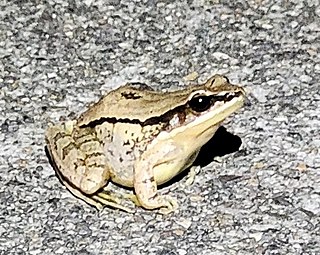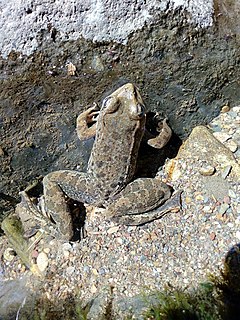Megastomatohyla is a genus of frogs in the family Hylidae. They are endemic to the cloud forests of central Veracruz and Oaxaca, Mexico. All are rare species with restricted distributions. The generic name is derived from Greek mega (="large") and stem of the genitive stomatos (="mouth"), referring to the enlarged oral disc of the tadpoles, juxtaposed with Hyla, the genus in which the four Megastomatohyla species were previously placed. Common name large-mouthed treefrogs has been coined for this genus.
Aromobates nocturnus, the skunk frog, is a species of critically endangered frog endemic to Trujillo State in Venezuela. It is an extremely rare frog, and no sightings have been recorded since the original description in the early 1990s.

The fairy tree frog is a species of frog in the family Hylidae endemic to Mexico. Its natural habitats are subtropical or tropical moist lowland forests, subtropical or tropical moist montane forests, and rivers. It is threatened by habitat loss.
The Mixe tree frog is a species of frog in the family Hylidae endemic to Mexico. Its natural habitats are subtropical or tropical moist montane forests and rivers. It is threatened by habitat loss.
The cloud forest tree frog is a species of frog in the family Hylidae endemic to Mexico. Its natural habitats are subtropical or tropical moist montane forests and rivers. It is threatened by habitat loss.
The Oaxacan yellow tree frog is a species of frog in the family Hylidae and is endemic to Mexico. Its natural habitats are subtropical or tropical moist montane forests and rivers. It is threatened by habitat loss.
The pine forest stream frog is a species of frog in the family Hylidae found in Guatemala and possibly Mexico. Its natural habitats are subtropical or tropical dry forests, rivers, and heavily degraded former forest. It is threatened by habitat loss.
The Kala forest tree frog, Leptopelis omissus, is a species of frog in the family Arthroleptidae found in Cameroon, the Republic of the Congo, Gabon, and Nigeria, and possibly Angola, the Central African Republic, the Democratic Republic of the Congo, and Equatorial Guinea. Its natural habitats are subtropical or tropical moist lowland forest, rivers, swamps, freshwater marshes, and heavily degraded former forests. It is threatened by habitat loss.
Gunther's robber frog, Günther's robber frog, or Guerreran robber frog is a species of frog in the family Craugastoridae. It is endemic to the Sierra Madre del Sur in the Guerrero state, Mexico. Its natural habitats are pine, oak, and pine-oak forests with plenty of leaf-litter on the ground. It is a relatively common species but declining and threatened by habitat loss and disturbance.
The Lancini's robber frog is a species of frog in the family Craugastoridae. It is endemic to Venezuela. Its natural habitat is tropical high-altitude grassland. It is threatened by habitat loss.
Megophrys edwardinae is a species of frog in the family Megophryidae. It is commonly known as the rough horned frog, Edwardina's horned frog, and Edwardina's spadefoot toad. It is endemic to northern Borneo and known from the Sabah and Sarawak provinces of Malaysia as well as from Brunei. Its natural habitats are tropical moist lowland forests and rivers. It is threatened by habitat loss.

Amolops chunganensis is a species of frog in the family Ranidae. Its type locality, Kuatun village in Wuyishan, Fujian. It is endemic to central, southern and eastern China where it has a wide but scattered distribution ; records from Vietnam probably refer to Amolops mengyangensis.

Quasipaa exilispinosa is a species of frog in the family Dicroglossidae. It is known under many common names, including Hong Kong spiny frog, common spiny frog, lesser spiny frog, little spiny frog, and Hong Kong paa frog. It has a patchy distribution in southern China including Hong Kong. Its natural habitats are subtropical hill streams in forests or shrublands, and sometimes also seepages, stream-fed marshes, and forests. It is threatened by over-collecting for human consumption and by habitat loss.

The horned forest frog or horned wrinkled ground frog is a species of frog in the family Ceratobatrachidae. It is endemic to the Philippines, where it is found in the Central Cordilleras of northern Luzon.
Odorrana kuangwuensis is a species of frog in the family Ranidae that is endemic to China. It is found in northeastern Sichuan and northwestern Hubei. Its name refers to the type locality, Mount Guangwu in Nanjiang County, northern Sichuan.

The highland frog, also known as the masked mountain frog, is a species of frog in the family Ranidae, known from El Salvador, Guatemala, Honduras, Mexico, and Nicaragua. Its natural habitats are subtropical or tropical moist lowland forests, subtropical or tropical moist montane forests, rivers, and freshwater marshes. It is threatened by habitat loss.
Pseudorana weiningensis is a species of true frog endemic to China. Its natural habitats are temperate shrubland, temperate grassland, and rivers. It is threatened by habitat loss.

Zweifel's frog is an amphibian species endemic to Mexico. It is a member of the true frog family, Ranidae.

Pseudophilautus femoralis is a species of frog in the family Rhacophoridae. It is endemic to Sri Lanka.

Pseudophilautus microtympanum, also known as Gunther's bubble-nest frog or small-eared shrub frog, is a species of frog in the family Rhacophoridae. It is endemic to the central hills of Sri Lanka. Its natural habitat are both closed and open canopy habitats. Sub-adults and juveniles are more often found in grassland and disturbed habitats, whereas adult frogs are usually found in closed-canopy habitats. It is threatened by habitat loss, agrochemical pollution, and the desiccation of its habitat.








